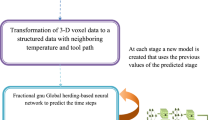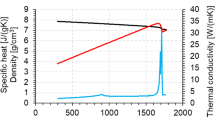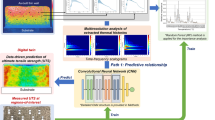Abstract
Typical computer-based parameter optimization and uncertainty quantification of the additive manufacturing process usually requires significant computational cost for performing high-fidelity heat transfer finite element (FE) models with different process settings. This work develops a simple surrogate model using a feedforward neural network (FFNN) for a fast and accurate prediction of the temperature evolutions and the melting pool sizes in a metal bulk sample (3D horizontal layers) manufactured by the DED process. Our surrogate model is trained using high-fidelity data obtained from the FE model, which was validated by experiments. The temperature evolutions and the melting pool sizes predicted by the FFNN model exhibit accuracy of \(99\%\) and \(98\%\), respectively, compared with the FE model for unseen process settings in the studied range. Moreover, to evaluate the importance of the input features and explain the achieved accuracy of the FFNN model, a sensitivity analysis (SA) is carried out using the SHapley Additive exPlanation (SHAP) method. The SA shows that the most critical enriched features impacting the predictive capability of the FFNN model are the vertical distance from the laser head position to the material point and the laser head position.


















Similar content being viewed by others
References
Abadi, M., Barham, P., Chen, J., Chen, Z., Davis, A., Dean, & Isard, M. (2016). Tensorflow: A system for large-scale machine learning. In 12th {USENIX} symposium on operating systems design and implementation ({OSDI} 16) (pp. 265–283).
Amari, S.-I. (1993). Backpropagation and stochastic gradient descent method Backpropagation and stochastic gradient descent method. Neurocomputing, 5(4–5), 185–196.
Arnst, M., & Ponthot, J.-P. (2014). An overview of nonintrusive characterization, propagation, and sensitivity analysis of uncertainties in computational mechanics: An overview of nonintrusive characterization, propagation, and sensitivity analysis of uncertainties in computational mechanics. International Journal for Uncertainty Quantification 4(5).
Baykasoğlu, C., Akyildiz, O., Tunay, M., & To, A. C. (2020). A process-microstructure finite element simulation framework for predicting phase transformations and microhardness for directed energy deposition of Ti6Al4V. Additive Manufacturing 101252.
Bhatt, P. M., Kabir, A. M., Peralta, M., Bruck, H. A., & Gupta, S. K. (2019). A robotic cell for performing sheet lamination-based additive manufacturing. Additive Manufacturing, 27, 278–289.
Cheng, Z., Wang, H., & Liu, G.-R. (2021). Deep convolutional neural network aided optimization for cold spray 3D simulation based on molecular dynamics. Journal of Intelligent Manufacturing, 32(4), 1009–1023.
Culmone, C., Smit, G., & Breedveld, P. (2019). Additive manufacturing of medical instruments: A state-of-the-art review. Additive Manufacturing, 27, 461–473.
Fetni, S., Enrici, T. M., Niccolini, T., Tran, H.-S., Dedry, O., Jardin, R., & Habraken, A. M. (2020). 2D thermal finite element analysis of laser cladding of 316L+ WC composite coatings. Procedia Manufacturing, 50, 86–92.
Garland, A. P., White, B. C., Jared, B. H., Heiden, M., Donahue, E., & Boyce, B. L. (2020). Deep convolutional neural networks as a rapid screening tool for complex additively manufactured structures. Additive Manufacturing 101217.
Gockel, J., & Beuth, J. (2013). Understanding Ti-6Al-4V microstructure control in additive manufacturing via process maps. In: Solid freeform fabrication proceedings (pp. 666–674).
Gulli, A., & Pal, S. (2017). Deep learning with Keras Deep learning with keras. Birmingham: Packt Publishing Ltd.
Guo, Y., Lu, W. F., & Fuh, J. Y. H. (2021). Semi-supervised deep learning based framework for assessing manufacturability of cellular structures in direct metal laser sintering process. Journal of Intelligent Manufacturing, 32(2), 347–359.
Haghighi, A., & Li, L. (2020). A hybrid physics-based and data-driven approach for characterizing porosity variation and filament bonding in extrusion-based additive manufacturing. 36, 101399.
Hann, S. Y., Cui, H., Nowicki, M., & Zhang, L. G. (2020). 4D printing soft robotics for biomedical applications. Additive Manufacturing 101567.
Hashemi, N., Mertens, A., Montrieux, H.-M., Tchuindjang, J. T., Dedry, O., Carrus, R., & Lecomte-Beckers, J. (2017). Oxidative wear behaviour of laser clad high speed steel thick deposits: Influence of sliding speed, carbide type and morphology. Surface and Coatings Technology, 315, 519–529.
Hoang, T.-V., & Matthies, H. G. (2021). An efficient computational method for parameter identification in the context of random set theory via bayesian inversion. International Journal for Uncertainty Quantification, 11(4).
Hoang, T.-V., Wu, L., Paquay, S., Golinval, J.-C., Arnst, M., & Noels, L. (2017). A computational stochastic multiscale methodology for mems structures involving adhesive contact. Tribology International, 110, 401–425.
Hofmann, D. C., Roberts, S., Otis, R., Kolodziejska, J., Dillon, R. P., Suh, J.-O., & Borgonia, J.-P. (2014). Developing gradient metal alloys through radial deposition additive manufacturing. Scientific Reports, 4, 5357.
Jardin, R. T., Tchuindjang, J. T., Duchêne, L., Tran, H.-S., Hashemi, N., Carrus, R., & Habraken, A. M. (2019). Thermal histories and microstructures in direct energy deposition of a high speed steel thick deposit. Materials Letters, 236, 42–45. https://doi.org/10.1016/j.matlet.2018.09.157
Jardin, R. T., Tuninetti, V., Tchuindjang, J. T., Hashemi, N., Carrus, R., Mertens, A., & Habraken, A. M. (2020). Sensitivity analysis in the modeling of a high-speed, steel, thin wall produced by directed energy deposition. Metals, 10(11), 1554.
Javaid, M., & Haleem, A. (2018). Additive manufacturing applications in medical cases: A literature based review. Alexandria Journal of Medicine, 54(4), 411–422.
Kamath, C. (2016). Data mining and statistical inference in selective laser melting. The International Journal of Advanced Manufacturing Technology, 86(5–8), 1659–1677.
Kamath, C., & Fan, Y. J. (2018). Regression with small data sets: a case study using code surrogates in additive manufacturing. Knowledge and Information Systems, 57(2), 475–493.
Kempen, K., Vrancken, B., Buls, S., Thijs, L., Van Humbeeck, J., & Kruth, J.-P. (2014). Selective laser melting of crack-free high density M2 high speed steel parts by baseplate preheating. The Journal of Manufacturing Science and Engineering, 136(6).
Kingma, D. P., & Ba, J. (2014). Adam: A method for stochastic optimization. arXiv preprint arXiv:1412.6980.
Kolossov, S., Boillat, E., Glardon, R., Fischer, P., & Locher, M. (2004). 3D FE simulation for temperature evolution in the selective laser sintering process. International Journal of Machine Tools and Manufacture, 44(2–3), 117–123.
Kumar, A., Paul, C., Pathak, A., Bhargava, P., & Kukreja, L. (2012). A finer modeling approach for numerically predicting single track geometry in two dimensions during laser rapid manufacturing. Optics and Laser Technology, 44(3), 555–565.
Kumar, L. J., & Nair, C. K. (2017). Current trends of additive manufacturing in the aerospace industry. In Advances in 3d printing & additive manufacturing technologies (pp. 39–54). Springer.
Lee, X. Y., Saha, S. K., Sarkar, S., & Giera, B. (2020). Automated detection of part quality during two-photon lithography via deep learning. Additive Manufacturing, 36, 101444.
Levine, S., Pastor, P., Krizhevsky, A., Ibarz, J., & Quillen, D. (2018). Learning hand-eye coordination for robotic grasping with deep learning and large-scale data collection. The International Journal of Robotics Research, 37(4–5), 421–436.
Li, J., Jin, R., & Hang, Z. Y. (2018). Integration of physically-based and data-driven approaches for thermal field prediction in additive manufacturing. Materials and Design, 139, 473–485.
Lin, P.-Y., Shen, F.-C., Wu, K.-T., Hwang, S.-J., & Lee, H.-H. (2020). Process optimization for directed energy deposition of ss316l components. The International Journal of Advanced Manufacturing Technology, 111(5), 1387–1400.
Lundberg, S. M., & Lee, S.-I. (2017). A unified approach to interpreting model predictions. In: Advances in Neural Information Processing Systems (pp. 4765–4774).
Lyons, B. (2014). Additive manufacturing in aerospace: Examples and research outlook. The Bridge, 44(3).
Manjunath, B., Vinod, A., Abhinav, K., Verma, S., & Sankar, M. R. (2020). Optimisation of process parameters for deposition of colmonoy using directed energy deposition process. Materials Today: Proceedings, 26, 1108–1112.
Mozaffar, M., Paul, A., Al-Bahrani, R., Wolff, S., Choudhary, A., Agrawal, A., & Cao, J. (2018). Data-driven prediction of the high-dimensional thermal history in directed energy deposition processes via recurrent neural networks. Manufacturing Letters, 18, 35–39.
Nagelkerke, N. J. (1991). A note on a general definition of the coefficient of determination. Biometrika, 78(3), 691–692.
Ngo, T. D., Kashani, A., Imbalzano, G., Nguyen, K. T., & Hui, D. (2018). Additive manufacturing (3D printing): A review of materials, methods, applications and challenges. Composites Part B: Engineering, 143, 172–196.
O’Malley, F. L., Millward, H., Eggbeer, D., Williams, R., & Cooper, R. (2016). The use of adenosine triphosphate bioluminescence for assessing the cleanliness of additive-manufacturing materials used in medical applications. Additive Manufacturing, 9, 25–29.
Park, H. S., Nguyen, D. S., Le-Hong, T., & Van Tran, X. (2021). Machine learning-based optimization of process parameters in selective laser melting for biomedical applications. Journal of Intelligent Manufacturing, 1–16.
Ren, K., Chew, Y., Zhang, Y., Fuh, J., & Bi, G. (2020). Thermal field prediction for laser scanning paths in laser aided additive manufacturing by physics-based machine learning. Computer Methods in Applied Mechanics and Engineering, 362, 112734.
Ribeiro, M. T., Singh, S., & Guestrin, C. (2016). “Why should I trust you?” explaining the predictions of any classifier. In Proceedings of the 22nd ACM SIGKDD international conference on knowledge discovery and data mining (pp. 1135–1144).
Roy, M., & Wodo, O. (2020). Data-driven modeling of thermal history in additive manufacturing. Additive Manufacturing, 32, 101017.
Shapley, L. S. (1953). A value for n-person games. Contributions to the Theory of Games, 2(28), 307–317.
Shen, H., Pan, L., & Qian, J. (2019). Research on large-scale additive manufacturing based on multi-robot collaboration technology. Additive Manufacturing, 30, 100906.
Stathakis, D. (2009). How many hidden layers and nodes? International Journal of Remote Sensing, 30(8), 2133–2147.
Wilson, D. R., & Martinez, T. R. (2003). The general inefficiency of batch training for gradient descent learning. Neural Networks, 16(10), 1429–1451.
Winkler, D. A., & Le, T. C. (2017). Performance of deep and shallow neural networks, the universal approximation theorem, activity cliffs, and qsar. Molecular Informatics, 36(1–2), 1600118.
Yang, Q., Zhang, P., Cheng, L., Min, Z., Chyu, M., & To, A. C. (2016). Finite element modeling and validation of thermomechanical behavior of Ti-6Al-4V in directed energy deposition additive manufacturing. Additive Manufacturing, 12, 169–177.
Zhang, Z., Farahmand, P., & Kovacevic, R. (2016). Laser cladding of 420 stainless steel with molybdenum on mild steel A36 by a high power direct diode laser. Materials Design, 109, 686–699.
Zhu, Q., Liu, Z., & Yan, J. (2020). Machine learning for metal additive manufacturing: Predicting temperature and melt pool fluid dynamics using physics-informed neural networks. arXiv preprint arXiv:2008.13547
Acknowledgements
This work was funded by Vingroup and supported by Vingroup Innovation Foundation (VINIF) under project code VINIF.2020.DA15. Also, the author would like to thank Dr. Van-Dung Nguyen for his helpful advice on various technical issues examined in this paper.
Author information
Authors and Affiliations
Corresponding author
Additional information
Publisher's Note
Springer Nature remains neutral with regard to jurisdictional claims in published maps and institutional affiliations.
Rights and permissions
About this article
Cite this article
Pham, T.Q.D., Hoang, T.V., Van Tran, X. et al. Fast and accurate prediction of temperature evolutions in additive manufacturing process using deep learning. J Intell Manuf 34, 1701–1719 (2023). https://doi.org/10.1007/s10845-021-01896-8
Received:
Accepted:
Published:
Issue Date:
DOI: https://doi.org/10.1007/s10845-021-01896-8




